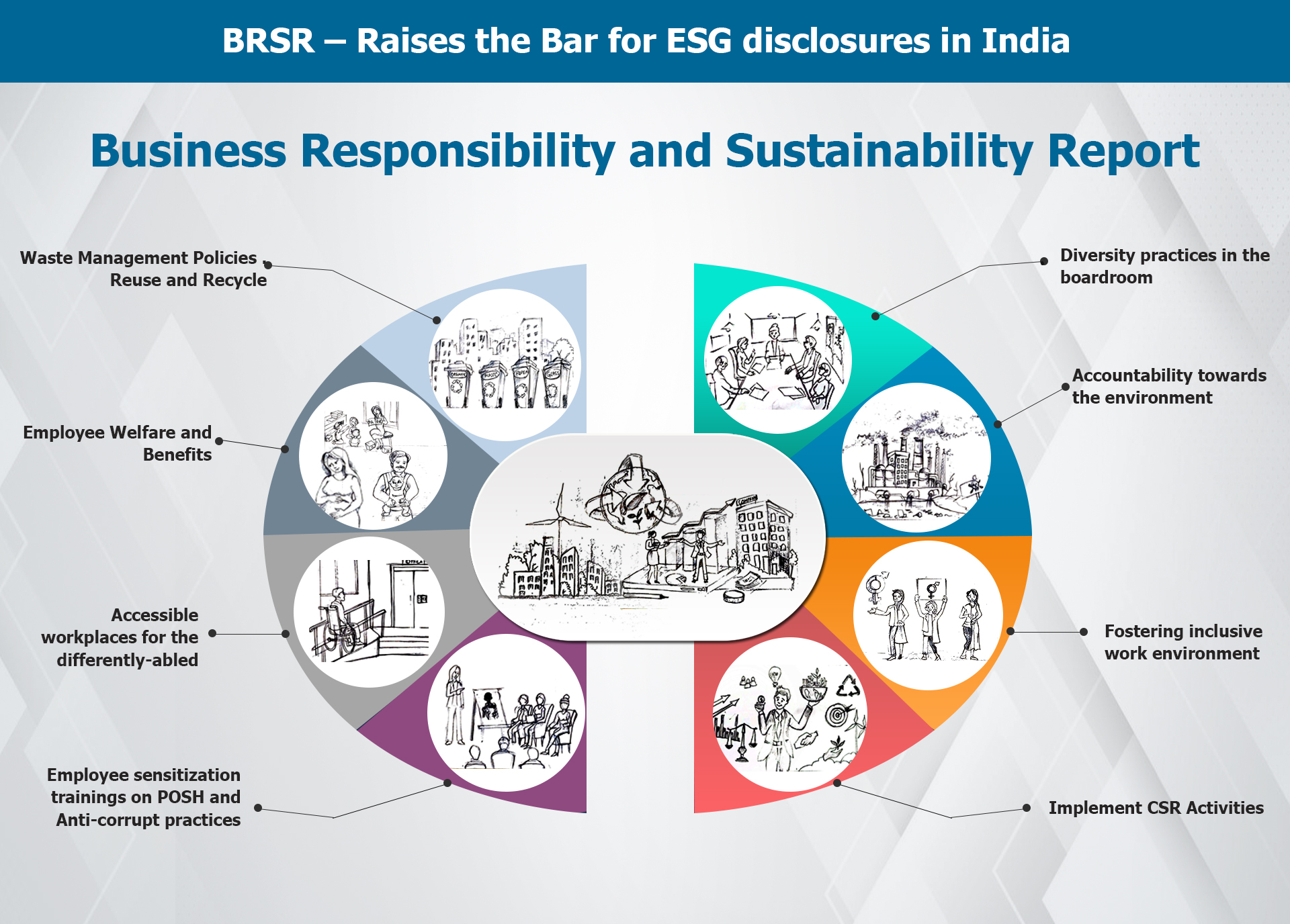View News
SEBI-BRSR-FRAMEWORK-AND-VALUE-CHAIN-DISCLOSURE-MANDATE-2023

ENHANCING CORPORATE TRANSPARENCY: SEBI'S BRSR FRAMEWORK AND VALUE CHAIN DISCLOSURE MANDATE
Introduction:
In recent years, Environmental, Social, and Governance (ESG) factors have become increasingly prominent in discussions surrounding corporate governance and sustainable business practices. Stakeholders, including investors, regulators, and consumers, are demanding greater transparency and accountability from companies regarding their ESG performance. To address this need, regulatory bodies like the Securities and Exchange Board of India (SEBI) have introduced frameworks such as the Business Responsibility and Sustainability Reporting (BRSR) format, aimed at enhancing corporate disclosure and accountability.
This article explores the implications of SEBI's BRSR framework and the recent mandate for value chain disclosure, highlighting its significance, challenges, and potential impacts on listed companies and their value chain partners. Additionally, it examines the strategies and measures companies can adopt to navigate these regulatory requirements effectively and enhance their ESG performance.
Understanding SEBI's BRSR Framework:
SEBI introduced the BRSR framework in May 2021, mandating the top 1,000 listed companies to include BRSR as part of their Annual Report filings from the financial year 2022-23 onwards. The framework aims to integrate ESG considerations into corporate reporting, thereby enabling stakeholders to assess a company's sustainability performance comprehensively.
Key Features of BRSR Framework:
1. Comprehensive Reporting: BRSR requires listed companies to disclose ESG-related information across nine key performance indicators (KPIs) under various ESG attributes, including greenhouse gas emissions, water footprint, energy footprint, and gender diversity.
2. Gradual Implementation: The mandate for BRSR reporting applies initially to the top 1,000 listed entities, with a phased approach to extend coverage to a broader set of companies over time.
3. Assurance Requirement: SEBI introduced reasonable assurance on BRSR Core attributes, emphasizing the importance of independent verification to enhance the credibility and reliability of reported information.
4. Value Chain Disclosure: Recognizing the significance of value chain impacts on ESG performance, SEBI introduced requirements for listed companies to disclose ESG-related information pertaining to their value chain partners.
Significance of Value Chain Integration:
A company's value chain encompasses the entire lifecycle of its products or services, including upstream and downstream activities such as sourcing, production, distribution, and disposal. Integrating value chain considerations into ESG reporting provides a holistic view of a company's sustainability performance and highlights the interconnectedness of ESG risks and opportunities across the supply chain.
Implications for Listed Companies:
The mandate for value chain disclosure presents both opportunities and challenges for listed companies:
- Opportunities:
1. Enhanced Transparency: Value chain disclosure enables companies to provide stakeholders with a more comprehensive understanding of their ESG performance, fostering trust and credibility.
2. Risk Identification: By assessing value chain impacts, companies can identify potential ESG risks and vulnerabilities within their supply chain and take proactive measures to mitigate them.
3. Stakeholder Engagement: Value chain disclosure encourages collaboration and engagement with value chain partners, driving collective action towards sustainable practices and responsible business conduct.
- Challenges:
1. Data Complexity: Mapping and assessing ESG impacts across the value chain require robust data collection and management systems, posing challenges for companies with complex and global supply chains.
2. Compliance Burden: Ensuring compliance with value chain disclosure requirements may entail additional costs and resource allocations, particularly for smaller companies with limited capacities.
3. Stakeholder Resistance: Value chain partners may be hesitant to disclose sensitive information or comply with new reporting obligations, leading to potential friction and resistance.
Penal Provisions for Inaccurate or Misleading Disclosures:
|
Regulatory Framework |
Penalty Provisions |
|
LODR Regulations |
- Imposition of fines - Suspension of trading - Freezing of promoter/promoter group holding of designated securities, as applicable, in coordination with depositories - Any other action specified by SEBI from time to time |
|
FUTP Regulation |
- Impounding and retaining proceeds or securities in respect of any transaction violating FUTP Regulation - Suspending trading of securities found to be or prima facie found to be involved in fraudulent and unfair trade practices - Restraining persons from accessing the securities market - Prohibiting any person associated with the securities market from buying, selling, or dealing in securities - Penalties as specified under Regulation 11, including fines and other actions, for violations of FUTP Regulation provisions |
|
Indian Contract Act, 1872 |
- Exposed to liability for fraud if knowingly providing false information with intent to deceive - Listed companies may potentially terminate contracts and take legal action against partners for losses resulting from fraudulent ESG disclosures |
|
Companies Act, 2013 |
- Exposed to liability for fraud under the Companies Act, 2013 if knowingly providing false information with intent to deceive - Listed companies may potentially terminate contracts and take legal action against partners for losses resulting from fraudulent ESG disclosure |
Strategies for Compliance and Risk Mitigation:
To effectively navigate the challenges associated with value chain disclosure, listed companies can adopt the following strategies:
1. Collaboration and Engagement: Foster collaboration and dialogue with value chain partners to promote understanding and alignment on ESG objectives and reporting requirements.
2. Capacity Building: Provide training and support to value chain partners to enhance their capabilities in ESG performance measurement and reporting.
3. Risk Assessment: Conduct thorough risk assessments to identify ESG risks within the value chain and develop targeted mitigation strategies.
4. Technology Adoption: Leverage technology solutions such as data analytics and blockchain to streamline data collection, verification, and reporting processes.
5. Legal Compliance: Ensure compliance with regulatory requirements and incorporate ESG obligations into supplier contracts and agreements.
6. Stakeholder Communication: Communicate transparently with stakeholders about value chain disclosure efforts, challenges, and progress made towards ESG goals.
|
SEBI Circular: BRSR Core Assurance & Disclosure Format Revisions Circular No.: SEBI/HO/CFD/CFD-SEC-2/P/CIR/2023/122. |
||||||||||||||||||||||||||||||||||||||||||||||||||||||||||||||||
|
Applicability of BRSR Core Assurance:
Applicability of Disclosure and Assurance for Value Chain:
BRSR Core Assurance Provider:
Changes in Revised Format of BRSR:
Annexure I – Format of BRSR Core Annexure II BUSINESS RESPONSIBILITY & SUSTAINABILITY REPORTING FORMAT |
Conclusion:
SEBI's BRSR framework and the mandate for value chain disclosure represent significant steps towards enhancing corporate transparency and accountability in India. By integrating value chain considerations into ESG reporting, listed companies can provide stakeholders with a more holistic view of their sustainability performance and drive positive change across the entire supply chain. While compliance with these requirements poses challenges, proactive engagement, collaboration, and technological innovation can help companies effectively navigate the evolving landscape of ESG reporting and meet stakeholders' expectations for transparent and impactful disclosures.
"Unlock the Potential of Legal Expertise with LegalMantra.net - Your Trusted Legal Consultancy Partner”
Article Compiled by:-
Mayank Garg
+91 9582627751
(LegalMantra.net Team)
Disclaimer: Every effort has been made to avoid errors or omissions in this material in spite of this, errors may creep in. Any mistake, error or discrepancy noted may be brought to our notice which shall be taken care of in the next edition In no event the author shall be liable for any direct indirect, special or incidental damage resulting from or arising out of or in connection with the use of this information Many sources have been considered including Newspapers, Journals, Bare Acts, Case Materials , Charted Secretary, Research Papers etc.

